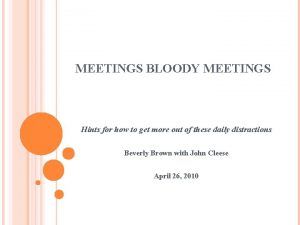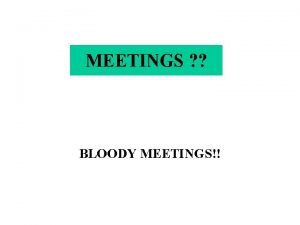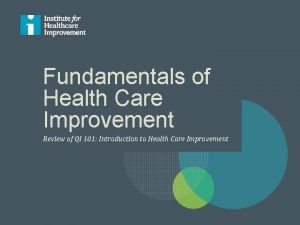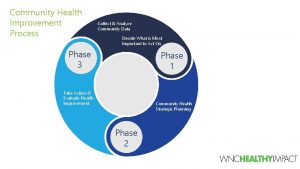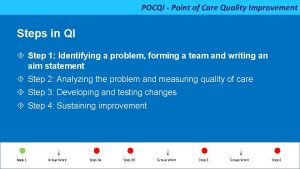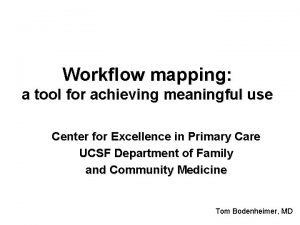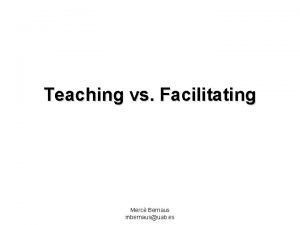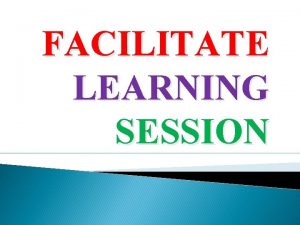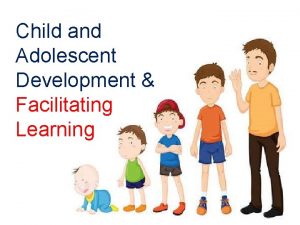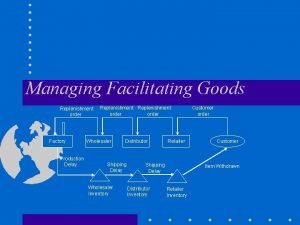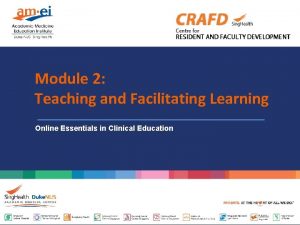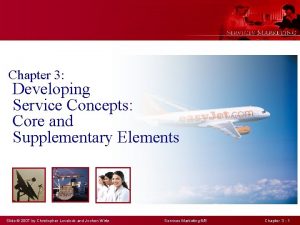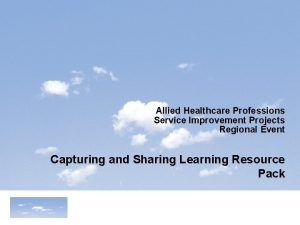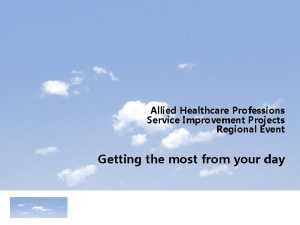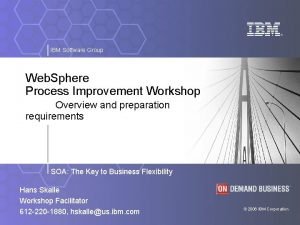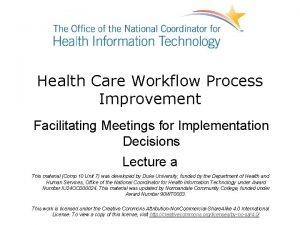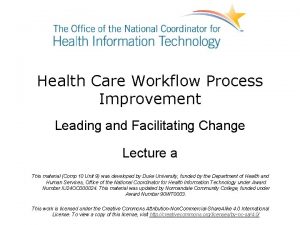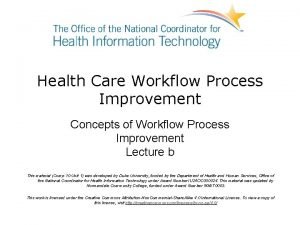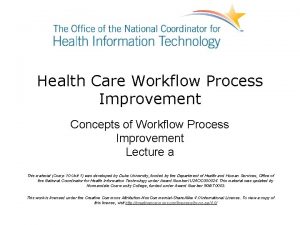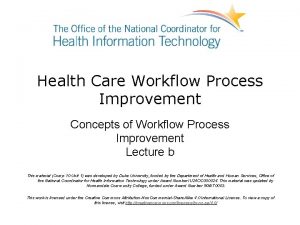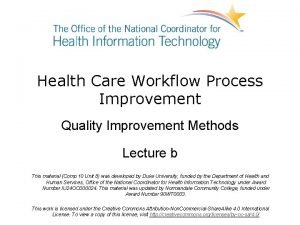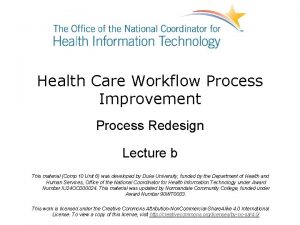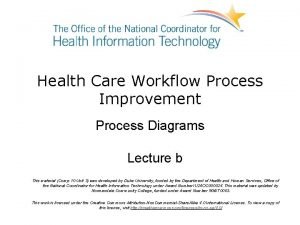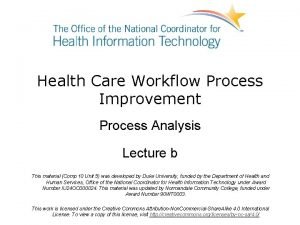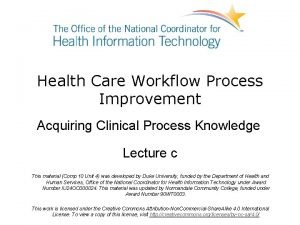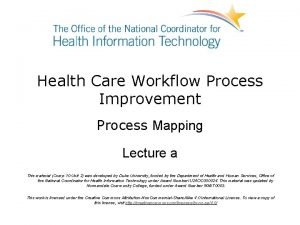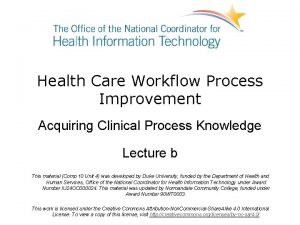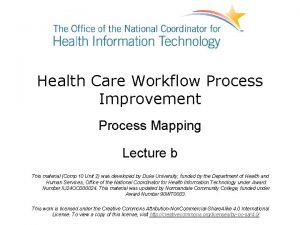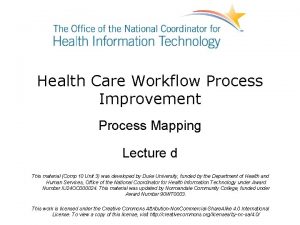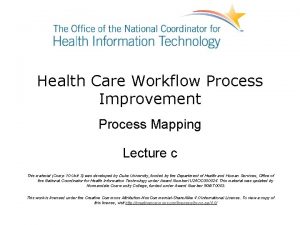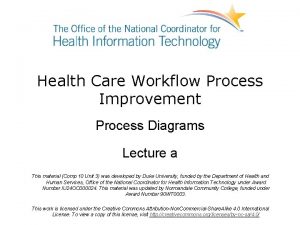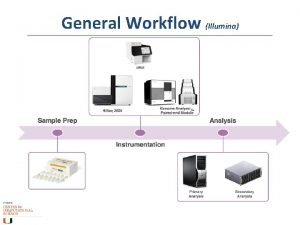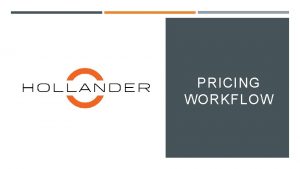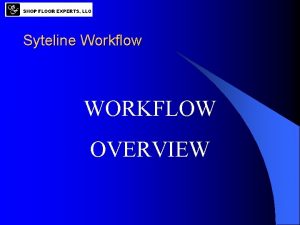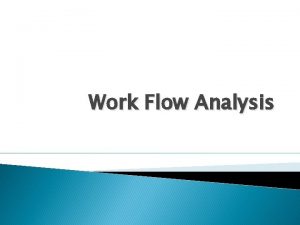Health Care Workflow Process Improvement Facilitating Meetings for

























- Slides: 25

Health Care Workflow Process Improvement Facilitating Meetings for Implementation Decisions Lecture a This material (Comp 10 Unit 7) was developed by Duke University, funded by the Department of Health and Human Services, Office of the National Coordinator for Health Information Technology under Award Number IU 24 OC 000024. This material was updated by Normandale Community College, funded under Award Number 90 WT 0003. This work is licensed under the Creative Commons Attribution-Non. Commercial-Share. Alike 4. 0 International License. To view a copy of this license, visit http: //creativecommons. org/licenses/by-nc-sa/4. 0/

Facilitating Meetings for Implementation Decisions: Learning Objectives • Describe major health care facility decisions in process redesign that includes EHR technology • Draft an agenda and facilitation plan for a decision making meeting, • Prepare a presentation to communicate findings of a workflow analysis or process redesign to health care facility decision makers, and • Document those decisions that are made and actions identified in a decision making meeting • Critique a decision making meeting agenda, facilitation plan or scenario to identify problems and how they could have been prevented 2

Topics • Making sure everyone understands how the new workflow might differ from the current processes • Identify which of the clinical workflow changes the clinic decision makers want to implement, • Prioritize these changes • Identify participant roles in the change implementation • Outline next steps to move forward based on the decisions 3

Major Decisions in EHR-related Process Redesign • • Which processes to automate or redesign Which redesign option to implement EHR functionality requirements How candidate systems measure up against requirements • Process change and system implementation plans 4

Effective Meetings “A single effective meeting will substantially change the capacity of a group to achieve desired outcomes” (Bolea & Scott, 2012) Effective meetings: • Face the current reality and gap between “as is” and “where we want to be” • Identify unused potential to improve, and • Commit to action / implementation plan 5

Health Care Decision-Making • In the health care field, the steps of making a decision may be remembered with the mnemonic BRAND, which includes – Benefits of the action – Risks of the action – Alternatives of the prospective action – Nothing: That is, doing nothing at all – Decisions 6

“BRAND” Change Matrix Template 7. 1 Table Change Matrix Template (courtesy of Dr. Meredith Nahm, 2012) 7

Example Process Redesign Meeting Might Include • Presentation of opportunities for redesign • For each redesign opportunity: – Rationale for the change: – Pros and cons of each competing redesign options, or analysis of multiple options to justify the chosen one – Cost assessment of making the change – Decision whether or not to move forward with the change, o if resources were limited, a priority for the change would be assigned. • Review of approved changes and their priority • Next steps 8

Meeting Purpose • to “tee up” the key decisions along with the information necessary to make them for the decision makers • and ultimately, to obtain the decisions needed to move the project toward successful completion. 9

The Role of the Meeting Facilitator • Facilitation – Process of designing/running a successful meeting • Practice Workflow and Information Management Redesign Specialist ’s role (as the facilitator) – Work with practice leadership to plan the agenda, – Attend to meeting logistics – Provide decision-making materials in advance – Conduct, maybe facilitate, the meeting – During the meeting, present or provide for presentation of decision-making materials – Gain agreement on next steps 10

Group Decision-Making Process • Process resulting in the selection of a course of action • Results in a “choice” • Systems – Consensus – Voting-based methods o Majority required o Plurality – Dictatorship 11

Meeting Participants Role • Work within the established ground rules • Review decision-making material in advance – Notify the facilitator in advance if additional information is needed – Provide “reality checks”, i. e, question options, rationale and assumptions used in cost/benefit analysis – Participate in decision-making • Participate actively in the meeting • Complete action items and follow-up as needed 12

Key Elements of Success • Involvement of key personnel – Have thought through potential solutions – Results in ownership of ideas o Solutions o Develops commitment for implementation • Immediate focus on changes which will make the greatest possible contribution to improvement and “Meaningful Use” • Initial implementation planning is begun in the next steps debriefing wrap-up session at the conclusion of the decision-making meeting 13

Exercise • A Patient check-in (registration) is shown in a process diagram on the following slide. Assume the practice leadership wishes to use consensus among the practice manager, senior nurse, two physician extenders and the two practice partners as the decision-making style. Assume that resources are limited and the process changes will need to be prioritized. 14

New Patient Check-in: Redesigned Process 7. 2 Figure New Patient Check In. (e. QHealth Solutions (formerly Louisiana Health Care Review) and the Mississippi Regional Extension Center, 2012) 15

Example Topics for Agenda • Introductions • Goal of the meeting and expected products • Review of documentation of process analysis and redesign • Summary & next steps 16

Decision-Making Materials • BRAND matrix • Process diagram 17

Meeting Logistics • Making arrangements for the meeting • Scheduling so that necessary decision makers can attend • Room size and layout • Supplies • Refreshments & breaks • Travel time & parking • Building access • Providing materials in advance such that participants have time to review them 18

Conducting the Meeting • Open the meeting by stating the meeting purpose – “to make decisions on …” • Review and follow the agenda • Monitor the agenda / time • Encourage participation from all attendees • Help participants reach consensus • Document decisions • Document next steps and follow-up / action items 19

Documenting a Meeting • Key information to be documented – Approved / denied process changes – Priorities for approved changes – Chosen alternatives • Next steps • Action and follow-up items 20

Debriefing Wrap-up • A wrap-up debriefing at the close of the meeting summarizes the decisions • The purposes of the debriefing are: – To confirm agreement – To agree on next steps to move forward with implementing approved changes 21

Methods for Other Decision. Making Meetings • Decision-making meetings = BRAND matrix • EHR functionality requirements = BRAND matrix with benefits, risks and alternatives are based on having vs. not having • Candidate systems = Scoring sheet • Process change and system implementation plan = BRAND matrix with implementation alternatives 22

Facilitating Meetings for Implementation Decisions Summary • Identified major types of EHR-related process decisions • Provided strategies, tools, and aids for planning and conducting a decision making meeting • Provided tools for documenting decisions made and actions identified in a decision-making meeting • Identified professional development areas related to planning and conducting meetings 23

Facilitating Meetings for Implementation Decisions References Bolea, A. , & Scott, B. (2010). Creating effective meetings. Retrieved from Business advisors. net: http: //business-advisors. net/files/dwnld/Creating_Effective_Meetings_a. pdf Group decision making. 2011. In Wikipedia. org. Retrieved from http: //en. wikipedia. org/wiki/Group_decision_making Charts, Tables, Figures 7. 1 Table: Courtesy of Dr. M Nahm, 2012. 7. 2 Figure: Permission for use by e. QHealth Solutions (formerly Louisiana Health Care Review) and the Mississippi Regional Extension Center. 2012 24

Facilitating Meetings for Implementation Decisions Lecture d This material was developed by Duke University, funded by the Department of Health and Human Services, Office of the National Coordinator for Health Information Technology under Award Number IU 24 OC 000024. This material was updated by Normandale Community College, funded under Award Number 90 WT 0003. 25
 Meeting bloody meetings
Meeting bloody meetings Bloody meetings
Bloody meetings Meetings bloody meetings 5 points
Meetings bloody meetings 5 points Qi 101: introduction to health care improvement
Qi 101: introduction to health care improvement Community health improvement process
Community health improvement process Wnchi
Wnchi Levels of health care primary secondary tertiary
Levels of health care primary secondary tertiary Unit 2 equality diversity and rights
Unit 2 equality diversity and rights Health and social component 3
Health and social component 3 Point of care quality improvement
Point of care quality improvement Workflow process mapping for ehr implementation
Workflow process mapping for ehr implementation Teaching vs facilitating
Teaching vs facilitating Facilitate learning session meaning
Facilitate learning session meaning Facilitating learning child and adolescent development
Facilitating learning child and adolescent development Examples of facilitating goods
Examples of facilitating goods Facilitating agencies in marketing channel
Facilitating agencies in marketing channel Specialized channel participants
Specialized channel participants Contactual efficiency examples
Contactual efficiency examples Facilitating learning module 2
Facilitating learning module 2 Factors influencing communication skills
Factors influencing communication skills Facilitating cultural change
Facilitating cultural change Core product and supplementary services
Core product and supplementary services Ohio state health improvement plan
Ohio state health improvement plan The allied health profession service improvement project
The allied health profession service improvement project The allied health profession service improvement project
The allied health profession service improvement project Ibm checkpoint goals examples
Ibm checkpoint goals examples
